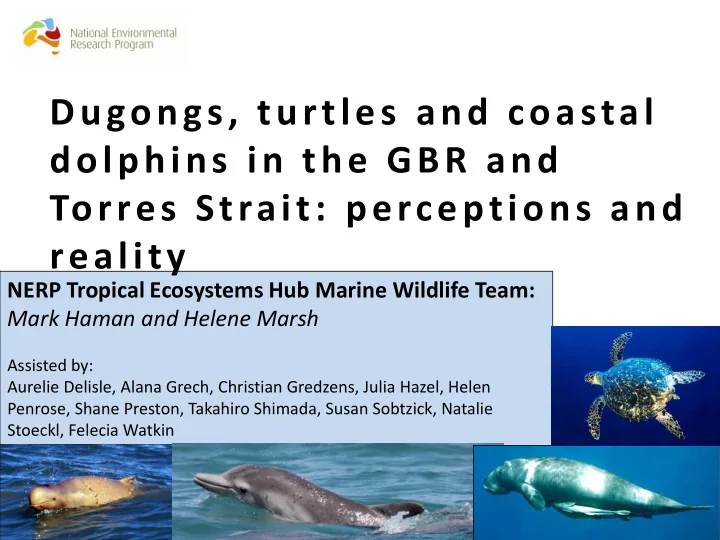

Dugongs, turtles and coastal dolphins in the GBR and Torres Strait: perceptions and reality NERP Tropical Ecosystems Hub Marine Wildlife Team: Mark Haman and Helene Marsh Assisted by: Aurelie Delisle, Alana Grech, Christian Gredzens, Julia Hazel, Helen Penrose, Shane Preston, Takahiro Shimada, Susan Sobtzick, Natalie Stoeckl, Felecia Watkin 1
Perception: hunting is the problem – especially for dugongs Call for change to Native Title Act to ban hunting of threatened species 2
Reality: >>> dugongs in Torres Strait & NGBR (where most hunting occurs) than SGBR 30,000 Dugong relative abundance 25,000 Sobztick et al. 2014 20,000 15,000 10,000 5,000 0 2000 2001 2002 2003 2004 2005 2006 2007 2008 2009 2010 2011 2012 2013 Northern Great Barrier Reef Southern Great Barrier Reef Torres Strait 3
Reality: Area high dugong density Torres Strait>> NGBR>> SGBR 4 Grech et al. 2012
Reality: Proportion of area of high dugong density much higher in Torres Strait and NGBR than SGBR Dugong relative density % survey units Survey area High Low +very +medium high Torres Strait 51.5 48.5 NGBR 58 42 SGBR 98.5 1.5 5
Reality: Status dugong population better in Torres Strait than GBR Results for most recent in time series of aerial surveys SGBR NGBR Torres Strait (2011) (2013) (2013) Relative worst worst best abundance (since 2000) Relative density worst worst best (since 2000) % calves worst worst best (since 1980s) 6
Green turtles and dugongs have high habitat overlap Protecting dugong habitat protects green turtles Gredzens et al. 2014 e.g. Shoalwater Bay SGBR 7
Reality: Turtle harvest western and central Torres Strait <1% abundance ‘harvested’ turtles Estimated abundance large female green turtles in survey area = 395,000 (potential range 283,000 – 657,000) Torres Strait turtle harvest similar magnitude to swale deaths at Raine Island in big nesting year Aerial survey sightings of turtles November 2013 8 Data from Skewes et al. 2005; Sobtzick et al 2014; Fuentes et al. 2014; Dunstan 2014
Green turtle futures: SGBR and NGBR stocks Population in SGBR healthy (~3% annual increase) QDEHP data Urban coast largely SGBR stock e.g. Low Isles – 95% greens from SGBR stock Long-term concerns for NGBR stock (NGBR and Torres Strait) - Raine Is recruitment failure 9
NGBR green turtles: Torres Strait Rookeries have normal hatching rates & nesting success Juvenile recruitment <<< expected – Raine Island recruitment failure Dauar Is only non sand cay nesting site: buffer to climate change Bramble Cay TS – cover of remote cameras Dauar (near Mer) – nesting beaches 10
Reality: Export of meat from Torres Strait no unlikely to be sustainability problem • Dugong and turtle <1% annual meat consumption of Queensland mainland Diaspora • Average per person per year: – 125 – 450g dugong – 160 - 580 g turtle • Used for home consumption and ceremonies If can’t source meat from Torres Strait – Islanders seek legally from SGBR TOs 11 Delisle et al. 2014
Policy implications of research Further protection required for dugongs in SGBR Protect remaining dugong hotspots in SGBR will protect green turtles too Shoalwater Bay Port Clinton 12
Policy implications of research Give Raine Island issues high priority Dunstan 2014 13
Policy implications of research: Defined take areas = tractable hunting management Grayson & Grech data Grayson (2011) Dugong Sanctuary 38% hunted 40% unofficial sanctuary 62% of high density dugong 22% Dugong 35 40% areas not hunted Sanctuary Community based management in hunted areas 14
Policy implications of research: Sharing of turtle and dugong meat between remote communities and Diaspora reduces pressure on SGBR stock 15
Policy implications of research: Need to inform the convertible 16
Snubfin and humpback dolphins: very small isolated inshore populations Both species mostly occur in isolated populations < 100 animals that can sustain only one human-caused mortality every few years but………………… Modelled by Alana Grech Isabel Beasley records Under-reported killer Under-reported killer 17
Reality: Most remaining populations close to ports ?affinity for river mouths Port Alma Townsville port 2014 <100 dolphins Cagnazzi et al.(2013). PLOS ONE Bathurst Bay 2014 18 Planned development 14-25% core habitat
Policy implications of research Need to identify and protect critical habitat of ‘protectable’ populations of coastal dolphins in GBR Critical habitat: 1.no new ports 2.no large mesh Buffer netting Buffer zone where managers 3. measures to work with fishers to minimize vessel implement strike etc ‘legitimate’ measures to minimize dolphin bycatch 19
Questions ? CONTACT Name: Helene Marsh Organisation: JCU Phone: 47814793 Email: helene.marsh@jcu.edu.au Environment and Heritage Protection 20
Recommend
More recommend